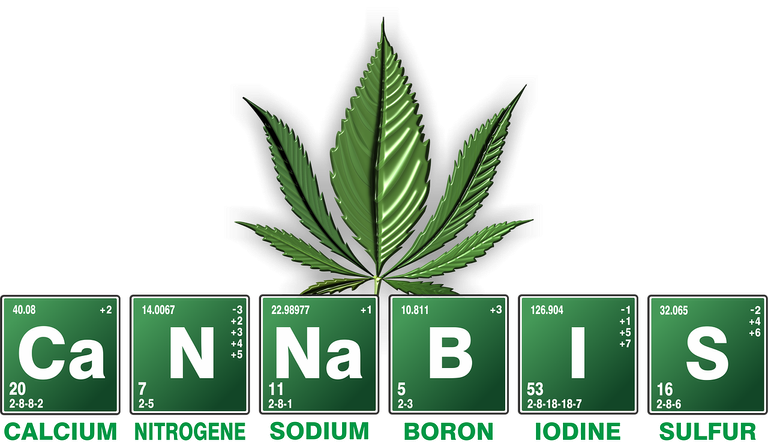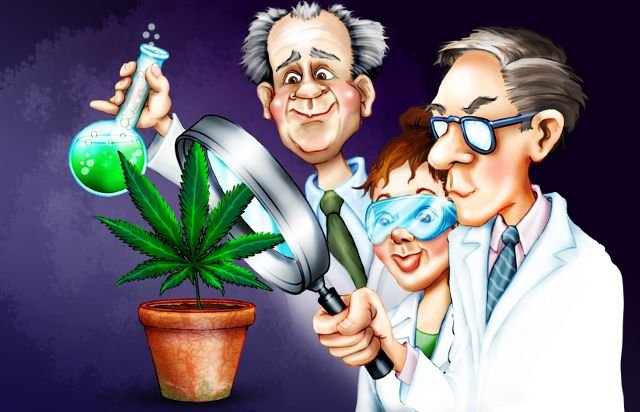
Cannabis is one of the most famous drugs and this fact is shown in statistics about the use of drugs (United Nations Office of Drugs and Crime, 2006). Around 3.9% of the worldwide population is noted as active users, but even more people have tried Cannabis at least once in their life. It is important to note that Cannabis has changed over time. The natural occurring Cannabis is relatively mild in comparison to the Cannabis, and Cannabis products (skunk, bhang, hashish), that can be bought today.
But Cannabis is not only a drug consumed by people for the known relaxing and mood elevating properties. Cannabis is also interesting for pharmaceutical uses as the ingredients in Cannabis have certain effects that could help patients. Some countries already use medical Cannabis to treat patients with chronic or terminal deceases, as the psychoactive substances (THC, cannabinol, and cannabidiol) in Cannabis relief pain and relax the patient. The problem is that Cannabis has negative side effects, as all drugs have. It can influence the appetite, cause tiredness, and mental slowness. Aside from the obvious problem of being an addictive substance. Another problem is the dosage of Cannabis, as low doses provide the best effect with as little negative effects as possible, but the patients build up a tolerance for the psychoactive substances and this will lead to higher dosages used for the same positive effect. At the same time the negative effects will increase in severity and at one point be stronger than the positive effects gained from using Cannabis.
Another negative effect shown by research in recent years is the problem that Cannabis seems to have relationships with some mental health problem (Hall and Degenhardt, 2007, 2009). These results lead Richardson (2010) to publish an article to review research on the influence of Cannabis use and the connection to depressions, anxiety disorders, mania, and psychosis.
Cannabis and depression

The first topic approached by Richardson (2010) was the connection between Cannabis use and depressions. Main points were the risk factors, dose and response, and age of first use. Richardson did not stop at this point but also considered research about self-medication, confounding variables and also looked at research that found no relationships between Cannabis use and the development of depression symptoms. Considering all these points will create a thorough discussion and conclusion, and will strengthen the objectivity of the article.
Richardson analysed data for risk factors and found that the possible development of depressions after the use of Cannabis seems to be stronger in women than men . Also the risk is higher for older users. It was not mentioned in the article if older users are also long term users or started using Cannabis at a later time in their life (Patton et al, 2002; Wilcox and Anthony, 2004).
The analysis for dose response effect showed that regular and heavy users have a higher risk of being diagnosed with symptoms of depression (Chen et al, 2002). But there is also research that did not find significant results for a dose response effect relationship and that occasional Cannabis users do not show no sign of for a link between Cannabis use and development of depression (Van Laar et al, 2007).
While considering the factor of the age when using Cannabis for the first time and continuation of usage Richardson analysed data that suggested that there might be a period of time during adolescents when the developing brain is more vulnerable to the negative effects of Cannabis use (De Graaf et al, 2010). Again this research found a stronger effect for female users (Wilcox and Anthony, 2004).
According to Richardson's analysis of research results the case of self-medication is low in depression cases. Also depression does not predict later use of Cannabis.
Looking at the confounding variables research Richardson (2010) found that if the research focused on these variables a connection between Cannabis use and the development of depression seems unlikely. That other factors seem more likely to explain the development of depressions (Lynskey et al, 2004). At the end it is mentioned that there are also research papers that controlled these confounding variables and still found a higher risk for developing depression in Cannabis users. It suggests an interaction between the effect of Cannabis use and the confounding variables.
At the end of the review for Cannabis use and depression Richardson reviewed research that found no connection. One study even suggested that regular users showed lowered levels of depression.
A study by Danielsson et al. (2015) looked into the connection between Cannabis use and the risk for depression and/or anxiety. A long time study over the course of 3 years was used to find a relationship between using and the risk for the disorders. This research also controlled for confounders and the results suggest that there is no association between Cannabis use and risks for depression and anxiety. The study also supports the notion that having these disorders increases the risk of becoming a Cannabis user.
Also a meta analysis by Lev-Ran et al. (2014) suggests that there might be a connection between Cannabis use and the risk to develop depressive disorders, but the lack of long term studies is a problem. As it is important to have a view on the cumulative effect of cannabis use and significant confounding factors. This could also show interactions between these factors.
In 2012 a study by Fairman et al. suggested that the use of Cannabis and the risk to develop a depressive disorder is moderate, even if the study is controlled for confounding factors. Also the age for the first time usage seems to have no effect on the risk for depression.
Cannabis and Anxiety

In Richardson's review the complex relationship between Cannabis use and anxiety disorders is explained with confounding factors, social anxiety, panic attacks and the effect of withdrawal. Research used by Richardson shows that intoxication with the psychoactive substances in Cannabis has an effect on anxiety. It increases the level of anxiety in the user.
But as with the depressive disorders the confounding variables have influence on the significance of Cannabis use in relationship to the effect on anxiety. When focusing on the confounding variables the significance of the Cannabis use drops.
Research towards panic attacks (Zvolensky et al, 2006, 2008, 2010) suggests that Cannabis use is related to the development of panic disorder, but if the research is controlled for the confounding variable of tobacco use the significance no longer remained.
When looking at the relationship between Cannabis use and social anxiety disorder, the relationship seems to be reversed (Buckner et al, 2008). The research suggest that people with anxiety disorder are at a higher risk of becoming Cannabis users.
Richardson mentioned a part of the research on this topic that seems to be ignored by many researchers. That anxiety is also part of the withdrawal symptoms (Bonn-Miller and Moos, 2009). It is the same with depression. It is important to know that withdrawal happens as soon as the psychoactive substances are no longer effecting the user. The research also showed that this effect is stronger for heavy users.
Contrary to the suggestions in Richardson's review a study by Feingold et al. (2016) suggests no association between the use of Cannabis and anxiety disorders or vice versa. It was a 3 year long study drawing data from a national epidemiologic survey on alcohol and related conditions. It was an interesting result, but considering the data the controls are difficult and the reliability of self reports are questionable when illegal substances are considered.
Other research reported in 2012 by Buckner et al. showed that anxiety, social and state anxiety in this case, increases the risk of Cannabis use and later associated problems. As the study used Cannabis users as participants it is hard to determine if the social anxiety increased the risk of using Cannabis or if the craving from withdrawal increased the risk. It is possible that the social and state anxiety reacted as a booster to strengthen and speed up the withdrawal effects. But the research shows that with the increased craving also the anxiety grew. So there definitely is an interaction between some forms of anxiety disorder and the use of Cannabis or vice versa.
Another study by Tournier et al. (2003) showed that participants with high levels of anxiety would use Cannabis as a self-medication to treat symptoms of their anxiety disorder.
Cannabis and Mania/Hypomania

For the relationship of Cannabis with Mania/Hypomania Richardson looked the bipolar disorder, the general population and self-medication.
Richardson's review showed that a majority of bipolar patients have been Cannabis users prior to their first bipolar episode (Frank et al, 2007). It is mentioned that it is still a controversy if Cannabis use can induce mania or hypomania, as it is said not to in handbooks like the DSM-IV-TR. But Richardson presented research that suggest it could be that Cannabis can induce manic or hypomanic episodes (Bertolin-Guillen et al, 2007).
When looking at the general population symptoms of mania seemed to be a result of prolonged exposure to the psychoactive substances in Cannabis rather than a short term reaction from intoxication (Henquet et al, 2006). So there is evidence suggesting that heavy users have manic symptoms, but only a few meet the diagnostic criteria for bipolar disorder (Arendt and Munk-Jorgensen, 2004).
In the area of self-medication research suggests both, that manic symptoms increase the risk for future Cannabis use and others found no such relationship.
Research by Bally et al. (2014) supports the notion of a relationship of Cannabis use and manic episodes as the majority of bipolar disorder patients seem to have been using Cannabis prior to their first episode, but the causal direction of this relationship still needs clarification.
A meta-analysis by Gibbs et al. (2015) suggests that Cannabis use could be a risk factor to induce and worsen manic symptoms.
Cannabis and Psychosis

In the last section of Richardson's review it can be seen that the connection between Cannabis use and psychosis has the largest body of literature. The reviewed research showed significant results that using Cannabis increases the risk for psychotic symptoms and development of schizophrenic episodes (Degenhardt et al, 2007).
He found little research evidence that there is a relationship with self-medication, but the research suggested that there could be a bi-directional relationship.
The frequent use of Cannabis seems to increase the risk and early users increases the risk of developing psychotic episodes and symptoms. Research also seemed to suggest that users already at risk of psychosis are more vulnerable. This suggests that cannabis use also boosts other confounding factors for developing psychosis symptoms. Lastly Richardson noted that there seems to be no specific cannabis psychosis (Richardson, 2010).
Research by Gage, Hickman and Zammit (2016) supports Richardson's results about Cannabis and psychosis, but also considers that more research will be needed to determine the real strength of the relationship and effect.
Conclusion and Future Research

Considering Richardson's review and recent research by other researchers, it is shown that the researchers are still divided on the topic, but realize the limitations of short term studies in this area. At this point in time the general results suggest little change between the review in 2010 by Richardson and more recent research. This might also have been a reason why it was often mentioned that more long term studies are needed to find a significant association between Cannabis use and the risks to develop mental health disorders. Also it might be worth looking into the possibility that Cannabis use alone does not have an effect on the risk at all, but reacts as a booster for confounding variables and other risk factors for mental health disorders. Or that Cannabis use is a stronger booster than it is a risk factor, if it is both.
Without further research on this topic a clear cut answer will be unlikely, if ever possible. Especially if research is influenced by society and the view on Cannabis that is represented by the society. As with most pharmaceutical products or interests research is funded with a certain goal.
More research in the area of self-medication with Cannabis could also be interesting. As some mental health disorder symptoms can be lowered and also there might be some kind of placebo effect at work through effect of the psychoactive substances. It should also be considered to broaden the research to take into account the many variations of Cannabis.
! Grammar errors if found can be kept as a present. English is not my native tongue.
! All pictures can be found on google.com
Fortunately the FDA has just recognized the medicinal benefits of CBD https://steemit.com/cannabis/@schemeshot/fda-recognizes-that-cbd-is-beneficial-and-is-looking-for-your-feedback